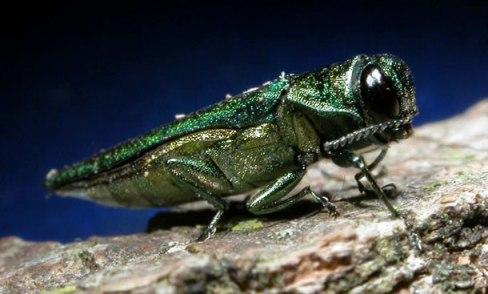
Image from http://www.emeraldashborer.info
The emerald ash borer is a beetle native to Asia. Metallic green and less than an inch long, this insect can easily fit on the surface of a penny. And it is capable of destroying ash trees.
The emerald ash borer was introduced into Michigan in 2002. It’s not clear how, but it was likely an unintentional introduction via wooden freight pallets and boxes used for shipping around the world. Since then, it has spread into Ohio, Indiana, Illinois, and is creeping its way into Wisconsin, Pennsylvania and beyond. The borer’s targets are any and all breeds of ash tree. Emerald ash borer larvae grow under the bark of the tree, tunneling through it until they become adults and leave the tree through a small, half-circle hole. After a couple of years of infestation, the ash tree is dead, and once a tree is infested, it is nearly impossible to save it.
Ash trees aren’t just beautiful decorations to public parks and people’s front lawns. It is a durable and flexible wood and is used in everything from furniture and flooring to tools and sports equipment. Not only are they a valuable product to many manufacturers, it is expensive to remove the dead and infected trees.
There are ways to protect the ash trees from the destructive beetle. If an area is under quarantine, do not remove wood from the area. Even if the tree is no longer living, the beetles could still be living in the wood. There are also chemical sprays for the tree leaves and soil to help prevent infestations altogether, but such treatments can get expensive for the everyday person, especially when the chemical has to be applied regularly.
The residents of Cleveland, Ohio are on a mission to save their trees using a new product that will hopefully be more effective than the spray chemicals and more satisfying than having to cut down the trees. This product, a chemical called emamectin benzoate, is injected into the tree. Holes are plugged to prevent the emerald ash borer from penetrating the bark of the tree. The injection will keep the beetles away for two to three years before another dose is required. This method is considered more environmentally and economically friendly than the traditional chemical sprays. Cleveland is home to around 6,500 ash trees. Perhaps this new treatment for the emerald ash borer will prevent the loss of some of those trees, and lead to new ways to hold the beetle at bay.

